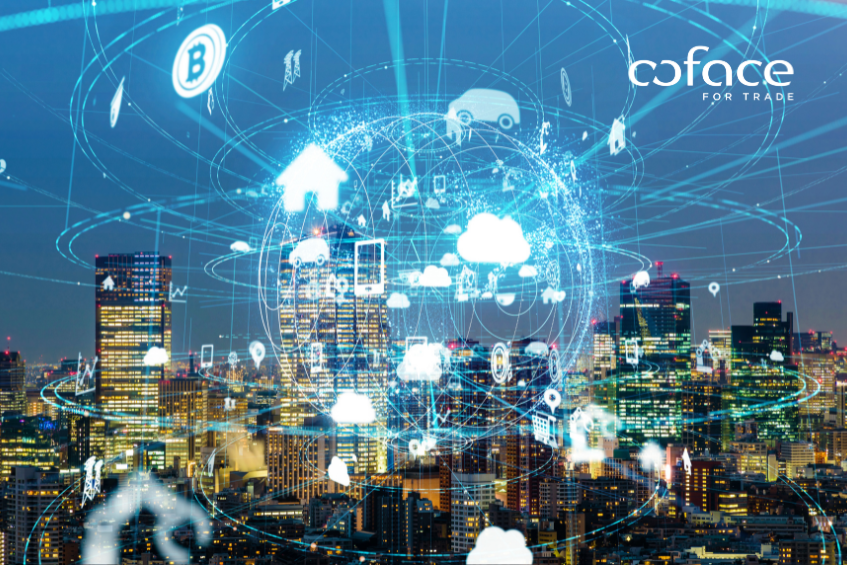Technology, Solutions and Innovations PR
Global AI Boom Masks A Deteriorating Outlook In The ICT Industry
By Aurelien DUTHOIT – Coface Economist
Last week, IT consultancy Gartner released its updated 2025 growth forecasts for global IT spending — a widely followed indicator of the sector’s health, built upon projections from the world’s largest technology firms. Reflecting signals already visible in retail trade, export data, corporate financials and earnings calls, Gartner revised its growth expectations downward to 7.9% from 9.8% in its previous January forecast (Chart 1). While the headline revision may appear modest, it masks a growing divergence within the ICT industry that raises important questions about the sustainability of current investment trends and the risks building beneath the surface.

The downward revision in Gartner’s 2025 forecasts reflects a growing divergence within the industry — between segments and between firms.
1) A two-speed industry. A closer look at Gartner’s breakdown reveals a stark contrast between segments. Spending on data centres is now expected to surge by 42%, up from 23% in January, driven by the rapid global rollout of AI-dedicated infrastructure. Hyperscalers such as Microsoft, Google, Meta, and OpenAI are engaged in a full-scale “arms race” to expand their utility-grade computing capacity.
In contrast, growth forecasts for the four other major segments have been cut by 25-50%. The slowdown is particularly pronounced in software (revised from 14% to 10%) and IT services (from 4% to 2%)—the two largest contributors to global IT spending growth over the past decade (Chart 2).

The slowdown in software and services spending comes as little surprise, reflecting a broader pullback in non-AI corporate investment amid persistent geopolitical and economic headwinds.
Meanwhile, the Devices segment remains largely driven by replacement cycles in consumer electronics, making it highly sensitive to shifts in consumer confidence and disposable income. Over the past decade, global IT spending has consistently softened during periods of weak GDP growth (2016, 2019, 2020).
2) Dispersion within segments. Even within software and IT services, growth is increasingly uneven. Many large vendors including Microsoft, Accenture, Infosys, and TCS have reported a slowdown in their legacy businesses. Clients are either freezing discretionary IT spending or reallocating budgets toward AI-related solutions, reinforcing the divide between high-growth and stagnating activities within segments.
Risks
1) Positive forecast bias. Gartner’s projections are largely based on data and guidance from IT vendors themselves, which tends to introduce a structural optimistic bias. Over the past decade, July forecasts were revised downward from January levels in seven out of ten years, with an average adjustment of around 3 percentage points. Similarly, final year-end results came in below July forecasts in seven of those ten years. Given the current level of global economic uncertainty, there is a strong likelihood that 2025 results will once again fall short of expectations.
2) Performance polarization among IT services and software companies. Much like Software-as-a-Service (SaaS) in the 2000s or cloud computing in the 2010s, AI could become a new competitive battleground, likely to favour fast movers but at the expense of laggards. Over the past two decades, even reputable companies such as HP Enterprise, Logica, DXC Technology, BT Global Services, Deutsche Telekom’s T-Systems, Oracle, and IBM have gone through prolonged periods of adjustment involving acquisitions, restructuring, or divestment. The case of Atos, one of Europe’s largest IT firms undergoing a major restructuring, serves as a reminder that the industry is far from risk-free. Smaller, niche players typical of the IT services and software sectors have far fewer options to adapt to this shifting competitive landscape.
3) Heightened risk in the Devices segment. Gartner’s Devices category includes smartphones, tablets, personal computers, and consumer electronics such as smartwatches and earbuds. Alongside fixed and mobile communications, it is among the most mature and fiercely competitive segments, marked by intense price pressure. While original equipment manufacturers (OEMs) such as Apple, Samsung, and Dell benefit from strong brand equity and relatively resilient margins, the electronics manufacturing services (EMS) firms to which they outsource production (Foxconn, Flex, Pegatron, Wistron, etc.) operate on far thinner margins, particularly among tier-two and tier-three suppliers. Beyond structural competition and a weakening demand outlook, EMS providers also bear the brunt of ongoing supply chain rebalancing in Asia. As production gradually shifts away from China toward alternative hubs such as Vietnam and Thailand, these firms face rising operational and geopolitical complexity.
4) Overcapacities in AI infrastructure. We reiterate warnings expressed in two previously released Briefs 1 : overcapacities worth hundreds of billions of dollars could materialize if AI companies were to fail to find a profitable business model to monetize their AI infrastructure. These overcapacities could have far-reaching consequences for two reasons:
a) AI infrastructure is not all about cutting edge equipment: While much of the AI investment narrative has focused on Nvidia’s fast-growing $150bn AI chip business, AI infrastructure also involves a broader range of goods, services, and companies that may be more vulnerable should overcapacities emerge. Based on data from data centre operators and IT firms, we estimate that servers account for just one-third of the initial investment in greenfield, AI-ready data centre projects in the US. Other critical components such as power and cooling systems, storage and networking equipment, and non-IT services like land acquisition and construction are equally exposed (Chart 3).

b) AI infrastructure is not solely driven by Big Tech. Similarly, while much of the media attention is focused on large announcements such as the US-backed USD500bn Stargate project, the vast majority of data centre capacity is still mostly owned and rented by so-called “colocation companies”, specialists renting out physical space, power, cooling, and network connectivity in their data centres to other companies. The share of hyperscalers, meaning companies owning and operating large-scale data centres (Open AI, Microsoft, Google, Meta, Amazon, in particular) varies between 15% and 40% across regions (Chart 4).

Although the share of hyperscalers is expected to grow, a significant portion of the operational risk will remain with colocation providers. These firms operate much like real estate management companies, and the largest among them such as Equinix, Digital Realty, CyrusOne, and QTS Realty are structured as real estate investment trusts (REITs) in the US. As such, they are exposed to similar risk factors, including interest rates, refinancing, and occupancy risks. They also face capital intensity and rapid asset depreciation typical of technology infrastructure businesses, with capital expenditures ranging from 20% to 35% of sales among the largest players. Credit ratings among top US players oscillate around the investment grade / speculative grade border. We believe the risk exposure of colocation companies is all the greater because of the business’ highly competitive nature which has attracted hundreds of small businesses. In the US, the world’s largest market for data centres, market concentration is very low: as of late 2024, the industry leader (Digital Realty) accounted for only 15% of total US capacities.
5) Currency effects. Finally, it’s worth noting that Gartner’s estimates are expressed in US dollars. Since January, the dollar has depreciated by roughly 8% on a trade-weighted basis, likely inflating the dollar value of international revenues. In 2015 already, the appreciation of the dollar had global IT spending recede by -5.5%, against a 2.5% increase in constant-currency terms. As Gartner does not publicly disclose its FX assumptions, the true extent of this effect remains unclear for 2025.
1 See “ICT : Artificial Intelligence ushers in a risky semiconductor cycle”, July 2024 and DeepSeek sends shockwaves across AI industry and financial markets”, January 2025
For more information: Visit www.coface.co.za.






 Sign-up and receive the Business Media MAGS newsletter OR SA Mining newsletter straight to your inbox.
Sign-up and receive the Business Media MAGS newsletter OR SA Mining newsletter straight to your inbox.